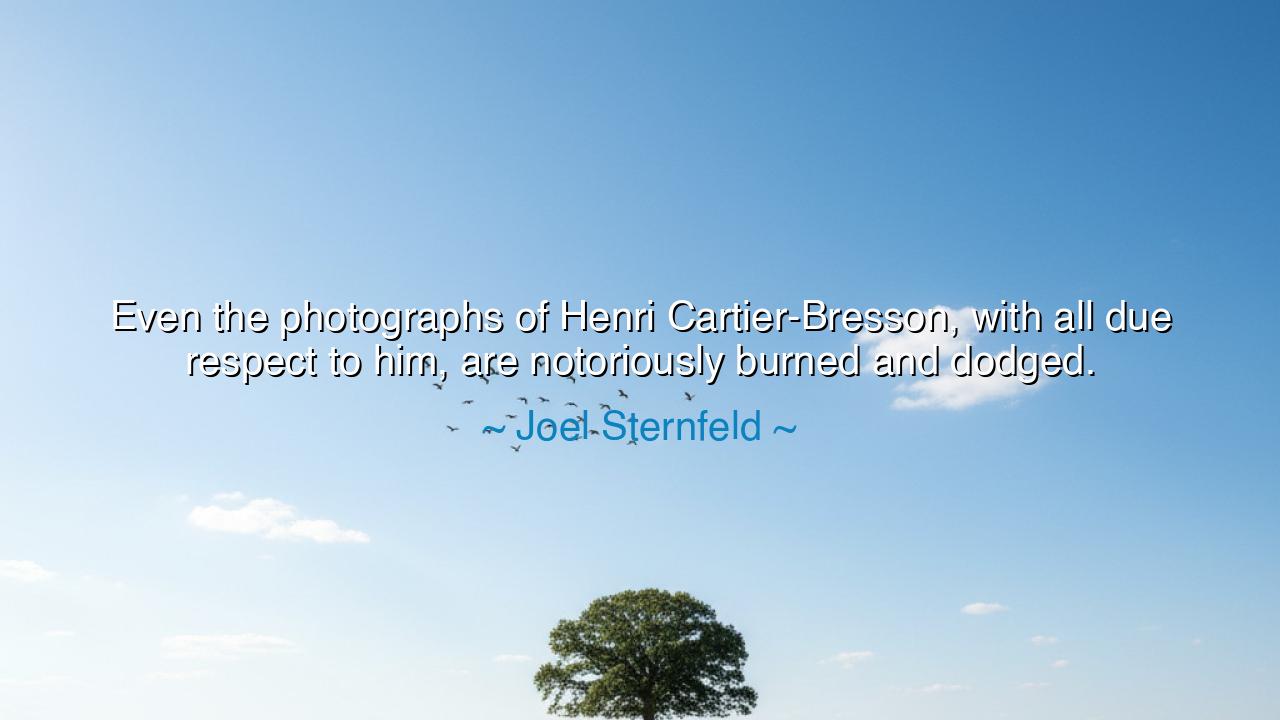
Even the photographs of Henri Cartier-Bresson, with all due
Even the photographs of Henri Cartier-Bresson, with all due respect to him, are notoriously burned and dodged.






"Even the photographs of Henri Cartier-Bresson, with all due respect to him, are notoriously burned and dodged." These words from Joel Sternfeld invoke a deep reflection on the nature of art, truth, and perception. Sternfeld's statement brings attention to the manipulation and interpretation inherent in the process of capturing reality. While Henri Cartier-Bresson is widely regarded as one of the greatest photographers of the 20th century, known for his masterful ability to capture the "decisive moment," Sternfeld suggests that even the most revered images are shaped by human intervention. Burning and dodging—terms used in the darkroom to alter exposure and enhance elements of a photograph—remind us that art, even in its most realistic forms, is never simply an objective representation of the world.
In the ancient world, the act of creating was often intertwined with the interpretation of truth. The Greek philosopher Plato, in his Theory of Forms, suggested that what we perceive through our senses is but a shadow of the true form of things. The world we see, hear, and touch is mediated by the mind’s interpretation, shaped by our own perceptions and biases. Much like Plato's view of art, Sternfeld’s words suggest that even the most realistic forms of art, such as photography, are filtered through the lens of the artist’s vision and intention. In this way, all representations of truth are, to some degree, altered by human influence—whether it’s through technique, style, or personal choice.
This concept is echoed in the stories of ancient sculptors and painters who, although celebrated for their realism, never intended to present mere replicas of the world. The works of Phidias, the great Greek sculptor, while admired for their lifelike quality, were infused with an idealized version of the human form. Phidias aimed not just to replicate the physical world but to capture the spiritual essence of his subjects, imbuing them with a sense of divine beauty. Similarly, Leonardo da Vinci in his paintings such as The Last Supper and Mona Lisa sought to transcend mere physical representation, seeking deeper emotional and spiritual truths through his art. Both Plato and these artists understood that reality was not a mere reflection of the visible world but was shaped by the vision of the creator, who sought to reveal deeper, often intangible truths.
Sternfeld’s critique of Cartier-Bresson challenges us to confront the role of the photographer in shaping reality. While Cartier-Bresson is known for capturing moments of spontaneous truth, Sternfeld’s reference to the technical manipulations of burning and dodging reminds us that even photographs, which are often revered as the most direct representation of truth, are still a form of artistic interpretation. Just as a painter chooses colors and brushstrokes to convey emotion or atmosphere, the photographer makes choices about light, framing, and exposure that influence the way we perceive the world. In this sense, the photographer, like the ancient artist, is not simply a passive recorder of reality but an active creator of meaning.
Consider the ancient Egyptians, who, in their artistic depictions, often portrayed figures in profile, not for realism but to convey the idealized form of the human body. The figure of Pharaoh was often depicted larger than life, not because the artist was ignorant of proportions, but because the size of the image reflected the divine authority of the ruler. These artistic choices were designed not to replicate the world exactly but to communicate the essence of a person’s power and divine connection. In the same way, Cartier-Bresson’s photographs, though highly praised for their authenticity, still reveal his interpretation of reality—shaped by the moments he chose to capture and how he chose to present them.
Sternfeld’s words carry a deeper lesson about the nature of truth and representation. Every artist, whether a photographer, painter, or sculptor, chooses what to reveal and what to obscure. Art is not just about capturing what is in front of us; it is about transforming that reality into something that speaks to the heart and mind. This is why art has the power to move us—to reveal truths that go beyond the surface. Just as Plato saw the Forms as the truest reality, artists shape their own versions of truth, and it is in the manipulation of that truth that the deeper essence of the world is revealed.
The lesson for us, then, is this: truth is not a static, unchanging entity that can be captured perfectly in one frame. It is a living, breathing concept, shaped by the artist’s choices and influenced by their perspective. Whether through the camera lens, the paintbrush, or the chisel, artists engage in an eternal process of revealing not just what the eye sees, but what the soul knows. Let us then look at art, including photography, not as a mere reflection of reality, but as a doorway to understanding the deeper, often hidden truths of the human experience. We, too, in our own lives, must recognize that our perspective and choices shape the world we see. Just as Cartier-Bresson’s photographs are an expression of his vision, so too is the way we live and perceive the world an expression of our own beliefs, values, and creative spirit.






AAdministratorAdministrator
Welcome, honored guests. Please leave a comment, we will respond soon